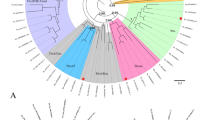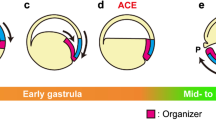Summary
In equally cleaving gastropods, the interactions between micromeres and macromeres involved in the determination of the mesentoblast mother cell (3D) were studied by changing the spatial arrangement of the micromeres by deleting one first quartet micromere or its progeny. A fixed relation was found between the deletion site and the place of origin of 3D; therefore, a fixed relation also exists in the configuration of the three remaining first quartet micromeres and the 3D. These results argue against the possibility that the animal-vegetal interactions do not choose between macromeres, but only permit the expression of a choice already made in another way and at another moment. The results are consistent with a stochastic model in which accidental differences between the macromeres in the number or extent of contacts with first quartet micromeres play a discriminating role during micromere — macromere interactions, that lead to 3D determination.
Embryos which lack a given first quartet micromere show a total absence of regulation in the larval head pattern; only the cephalic plates show regulative abilities while forming the adult head structures. Therefore, in later stages new activating and restraining factors seem to play a part in the head development.
Similar content being viewed by others
References
Arnolds WJA (1979) Silver staining methods for the demarcation of superficial cell boundaries in whole mounts of embryos. Mikroskopie 35:202–206
Arnolds WJA (1982a) A mutation with a maternal effect inLymnaea stagnalis L., affecting development of bilateral symmetry and dorsoventrality and preventing gastrulation. Proc Kon Ned Akad Wetensch C85:1–20
Arnolds WJA (1982b) Early development of maternally determined mutant dauerblastulae inLymnaea stagnalis L.; Cellular interactions in the dorsalization and lateralization of head quadrants. Proc Kon Ned Akad Wetensch C85:635–662
Berube GR, Powers MM, Kerkay J, Clark GG (1966) The gallocyaninchromalum stain; influence of methods of preparation on its activity and separation of active staining compound. Stain Technol 41:73–81
Biggelaar JAM van den (1971) Timing of the phases of the cell cycle during the period of asynchronous division up to the 49-cell stage inLymnaea. J Embryol Exp Morphol 26:367–391
Biggelaar JAM van den (1976a) Development of dorsoventral polarity preceding the formation of the mesentoblast inLymnaea stagnalis. Proc Kon Ned Akad Wetensch C79:112–126
Biggelaar JAM van den (1976b) The fate of maternal RNA-containing ectosomes in relation to the appearance of dorsoventrality in the pond snailLymnaea stagnalis. Proc Kon Ned Akad Wetensch C79:421–426
Biggelaar JAM van den (1977a) Significance of cellular interactions for the differentiation of the macromeres prior to the formation of the mesentoblast inLymnaea stagnalis. Proc Kon Ned Akad Wetensch C80:1–13
Biggelaar JAM van den (1977b) Development of dorsoventral polarity and mesentoblast determination inPatella vulgata. J Morphol 154:157–186
Biggelaar JAM van den, Guerrier P (1979) Dorsoventral polarity and mesentoblast determination as concomitant results of cellular interactions in the mollusePatella vulgata. Dev Biol 68:462–471
Biggelaar JAM van den, Dorresteijn AWC, Laat SW de, Bluemink JG (1981) The role of topographical factors in cell interaction and determination of cell lines in molluscan development. In: Schweiger HG (ed) International Cell Biology 1980–1981. Springer, Berlin Heidelberg New York, pp 526–538
Clement AC (1967) The embryonic value of the micromeres inIlyanassa obsoleta, as determined by delection experiments. I. The first quartet cells. J Exp Zool 166:77–88
Dam WJ van, Verdonk NH (1982) The morphogenetic significance of the first quartet micromeres for the development of the snailBithynia tentaculata. Wilhelm Roux's Arch 191:112–118
Dongen CAM van (1976) The development ofDentalium with special reference to the significance of the polar lobe. V and VI. Differentiation of the cell patterns in lobeless embryos ofDentalium vulgare (da Costa), during the late larval development. Proc Kon Ned Akad Wetensch C79:245–266
Dongen CAM van, Geilenkirchen WLM (1975) The development ofDentalium with special reference to the significance of the polar lobe. IV. Division chronology and development of the cell pattern inDentalium dentale after removal of the polar lobe at first cleavage. Proc Kon Ned Akad Wetensch C78:358–375
Morrill JB, Blair CA, Larsen WJ (1973) Regulative development in the pulmonate gastropodLymnaea palustris, as determined by deletion experiments. J Exp Zool 183:47–56
Raven ChrP (1963) The nature and origin of the cortical morphogenetic field inLimnaea. Dev Biol 7:130–143
Raven ChrP (1970) The cortical and subcortical cytoplasm of theLymnaea egg. Int Rev Cytol 28:1–44
Raven ChrP (1974) Further observations on the distribution of cytoplasmic substances among the cleavage cells inLymnaea stagnalis. J Embryol Exp Morphol 31:37–59
Verdonk NH (1965) Morphogenesis of the head region inLimnaea stagnalis L. Ph D Thesis University of Utrecht, The Netherlands
Verdonk NH (1979) Symmetry and asymmetry in the embryonie development of molluscs. In: Spoel S van der, Bruggen AC van, Lever J (eds) Pathways in malacology, Bohn, Scheltema & Holkema, Utrecht, pp 25–45
Verdonk NH, Groot S de (1970) Periodic changes in sensitivity ofLymnaea eggs to a heat shock during development. Proc Kon Ned Akad Wetensch C73:171–185
Author information
Authors and Affiliations
Rights and permissions
About this article
Cite this article
Arnolds, W.J.A., van den Biggelaar, J.A.M. & Verdonk, N.H. Spatial aspects of cell interactions involved in the determination of dorsoventral polarity in equally cleaving gastropods and regulative abilities of their embryos, as studied by micromere deletions inLymnaea andPatella . Wilhelm Roux' Archiv 192, 75–85 (1983). https://doi.org/10.1007/BF00848483
Received:
Accepted:
Issue Date:
DOI: https://doi.org/10.1007/BF00848483




